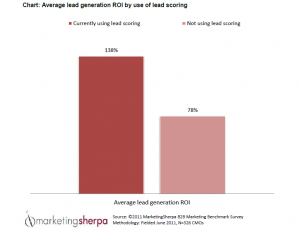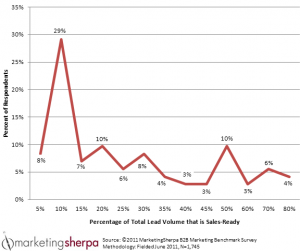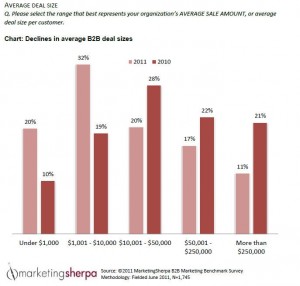In last week’s blog post, I looked at the importance of lead nurturing. Some readers wanted more, so this week, I’ll dive even deeper into the complex B2B sale with a few data points and some very actionable tips on lead scoring.
First, let’s look a few data points from the 2012 MarketingSherpa B2B Benchmark Report, featuring Jen Doyle, Senior Research Manager, MarketingSherpa, as the lead author.
This chart shows the value of scoring leads based on a survey of CMOs:

Click to enlarge
Here is commentary on this chart from the report (italic emphasis is mine in the quote):
Once organizations establish lead qualification practices and define the criteria for a qualified, sales-ready lead, they need lead scoring methodologies to accurately and precisely identify qualified leads. Lead scoring is the process of adding and subtracting points to a lead’s value over time based on various lead attributes or demographics, and behaviors.
Lead scoring is one essential component of an overall funnel optimization strategy; however, the above chart analyzes one of the key benefits of only implementing this one feature. On average, organizations that currently use lead scoring experience a 77% lift in lead generation ROI, over organizations that do not currently use lead scoring.
Okay, so lead scoring is clearly a good B2B marketing practice, but the next data point isn’t so positive. Our research, through a survey of 1,745 marketers, found that 79% of B2B marketers are not engaging in lead scoring.
This week’s B2B newsletter article – “The Complex Sale: Lead scoring effort increases conversion 79%” – is a look at how Bersin & Associates, a human resources and learning professionals research and consulting firm, implemented an entirely new lead scoring program over 2011.
I interviewed Paula Reinman, Senior Vice President Marketing, Bersin, to learn the process Marketing and Sales at the company went through to create and implement a lead scoring program that fit in with the existing marketing automation software and CRM environment.
I think if you take the time to read the case study, you will take away a solid sense of implementing lead scoring, but as they say in New Orleans, this week I’m offering some lagniappe, a little something extra from Paula in the form of six lead scoring tips.
Hopefully these will help either improve your lead scoring activities, or even spur you to set up a program of your own if you aren’t currently engaging in lead scoring.
Here are Paula’s lead scoring tips:
Read more…














